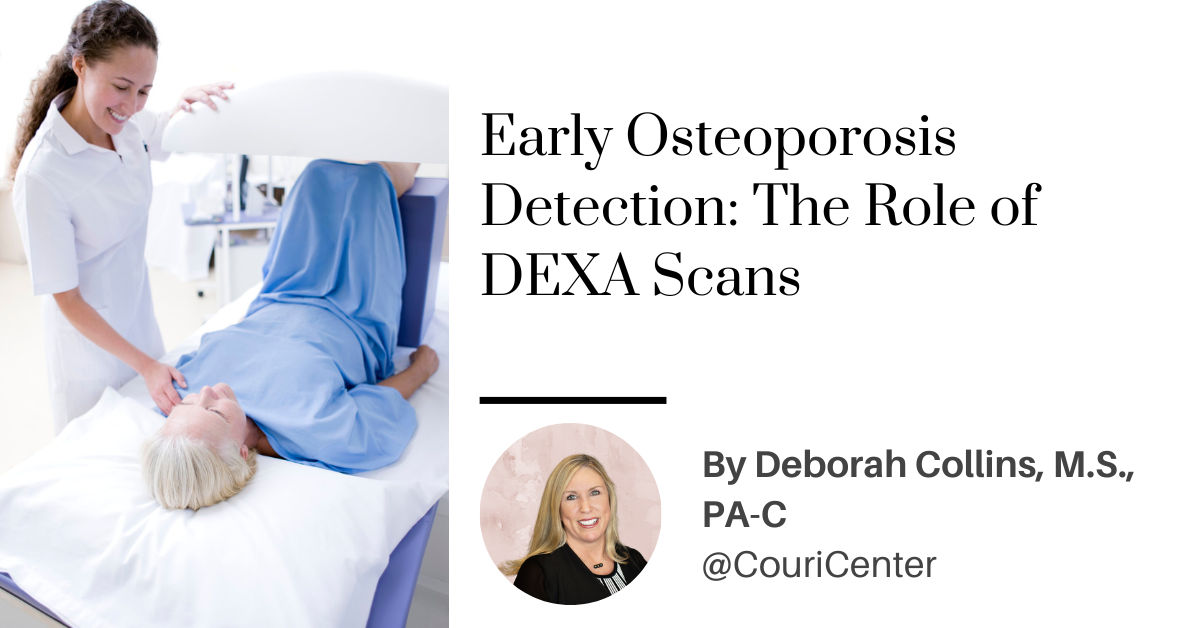
Summary
In her blog, Couri Center's Physician Assistant, Deborah Collins, highlights the importance of early detection and management of osteoporosis, which affects over 200 million people worldwide. Particularly impacting women over 50, osteoporosis leads to weakened bones and a higher risk of fractures. The key to early detection is a painless DEXA scan, which measures bone mineral density and provides crucial T score results for assessing fracture risk. With associations with various conditions such as rheumatoid arthritis and chronic kidney disease, timely intervention is essential. For those at risk, Collins recommends scheduling a consultation at the Couri Center to discuss preventive measures and treatment options.
Osteoporosis is a systemic skeletal disease that affects over 200 million people each year. Half of all women over the age of 50 are at risk of fracturing a bone in their lifetime and should be screened for Osteoporosis. Osteoporosis is characterized by low mineral bone mass, microarchitectural deterioration of bone tissue, and decreased cortical thickness. The clinical outcome of Osteoporosis is called a “Fragility Fracture,” or a bone fracture that occurs in the setting of a low-level trauma that would not normally occur in other individuals.
Low bone mass or Osteoporosis screening can be readily detected in a clinical setting by measuring low bone mineral density (BMD) using a Dual Energy X-ray Absorptiometry (DEXA).
How it works and why it is important
A scan is performed on a padded table with a scanner that passes over your body and emits a very low-dose X-ray. The X-rays are absorbed differently by bones and soft tissues, allowing the machine to measure the amount of X-ray that passes through your bones. The process itself is painless and noninvasive. It is a 10-minute test that provides valuable information about an individual’s bone health.
The results of the DEXA scan are usually reported as a T score and sometimes a Z score for individuals who are not menopausal. The T score compares your bone density to that of a healthy young adult of your sex. It determines your risk of fracture. A Z score compares the bone density to that of people your own age, sex, and size and helps identify other factors that might be affecting bone density.
The interpretation of the exam:
- T score of -1.0 and above is considered normal.
- T score between -1.0 and -2.5 indicates low bone density ( osteopenia)
- T score 0f -2.5 and below indicates osteoporosis.
A DEXA scan is helpful for:
- Screening and diagnosis of osteoporosis/osteopenia
- Monitoring changes in bone density over time
- Assessing the effectiveness of osteoporosis treatment
Medical Conditions associated with Osteoporosis:
- Autoimmune
- Rheumatoid arthritis
- Chronic obstructive pulmonary disease (COPD) and asthma
- Chronic kidney disease (CKD)
- Digestive and gastrointestinal
- Diseases of malabsorption (Celiac, Crohn’s, inflammatory bowel disease)
- Lactose intolerance
- Endocrine and hormonal
- Endocrine disorders (e.g., Cushing’s syndrome, hyperparathyroidism, diabetes)
- Hypogonadal states (male and female; primary or secondary; e.g., Turner syndrome/Kleinfelter syndrome, amenorrhea, Kallmann syndrome)
- Haematologic
- Neurological
- Psychophysiological disorders and mental illness
- Anorexia nervosa
- Dementia
- Cancer
- HIV/AIDS
- Some inherited disorders
- Immobility
- Chronic disease in childhood
If you are Menopausal or are at high risk for Osteoporosis, please schedule an appointment at the Couri Center to discuss this with your provider and consider a DEXA scan. Early detection, prevention, and intervention will result in better outcomes and aid in treating Osteoporosis.
Deborah Collins, M.S., PA-C
Sources:
https://www.osteoporosis.foundation/health-professionals/about-osteoporosis
DISCLAIMER: THE INFORMATION PROVIDED ON THIS WEBSITE IS INTENDED FOR GENERAL INFORMATIONAL PURPOSES ONLY AND IS NOT INTENDED TO BE A SUBSTITUTE FOR PROFESSIONAL MEDICAL ADVICE, DIAGNOSIS, OR TREATMENT. THE INFORMATION PROVIDED IS CURRENT AS OF THE DATE OF PUBLICATION OR LAST REVIEW, BUT MEDICAL KNOWLEDGE IS CONSTANTLY EVOLVING, AND THE INFORMATION MAY BECOME OUTDATED OVER TIME.
